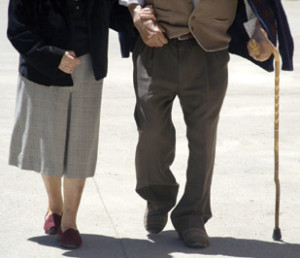
istockphoto.com 1794699
Wedges assist stroke rehab
Research offers new slant on insole use
Most of the research on laterally wedged insoles to date has focused on potential applications related to osteoarthritis. But a recent study from Taiwan suggests the technique may also have benefits for stroke patients.
In a study of 10 hemiparetic stroke patients, researchers from National Taiwan University found that use of a 5º laterally wedged insole on the nonparetic side not only improved stance symmetry but also reduced the knee adduction moment in the paretic limb. The results were e-published in the October 30 issue of the American Journal of Physical Medicine & Rehabilitation.
The investigators analyzed the study subjects during quiet stance and while ambulating, with no wedge, a wedge on the paretic side, and a wedge on the nonparetic side. Subjects wore open-toe leather shoes that were custom-designed for easy insertion of the wedged insoles. Insoles were full-length EVA, with a lateral thickness of about 8 mm and a 5º slope.
Use of the wedge on the nonparetic side had the immediate effect of increasing weightbearing on the paretic limb, improving symmetry during quiet stance. This finding was consistent with that of an April 2002 Archives of Physical Medicine & Rehabilitation study, in which researchers from Chicago compared different shoe wedges and lifts and found that a 5º wedge on the nonparetic side resulted in the most symmetrical weight distribution during stance.
The Taiwanese researchers did not find that the immediate effects of the wedge on symmetry during stance extended to symmetry during ambulation. Weightbearing on the paretic side was increased during initial contact with the use of a wedge on the paretic side and during preswing with a wedge on the nonparetic side, but those changes were not statistically significant.
Previously, investigators from the University of Occupational and Environmental Health in Kitakyushu, Japan, found that weight-bearing symmetry during gait improved significantly in six hemiplegic stroke patients after one week of using a 7º wedge on the affected side. Those results were published in the December 2003 issue of the Journal of the University of Occupational and Environmental Health. The Taiwanese authors suggested that perhaps more than 5º would be needed to see ambulatory effects, but also cautioned that greater degrees of wedging on just one side could lead to patient discomfort. They also proposed that symmetry during ambulation could be improved with verbal instructions for weight shifting toward the paretic side, as in the Japanese study.
The researchers from Taiwan did find that the insoles had a significant effect on knee adduction moment during ambulation, however. Use of the wedged insole on the paretic side significantly reduced the knee adduction moment on that same side, which is consistent with previous studies of osteoarthritis patients. In the stroke patients, however, use of the wedged insole on the nonparetic side also significantly reduced the knee adduction moment in the paretic limb.
Wedging on either side did not significantly affect walking velocity, cadence, step length, single-support vertical ground reaction force, or joint angles in the frontal plane.
The authors theorized that the reduced knee adduction moment might be the result of reduced internal load on the knee abductor muscles, suggesting that the wedged insoles might help decrease hip and knee pain in the stroke subjects as well as decreasing their risk of osteoarthritis progression in the paretic limb.
They also suggested that, in cases where an ankle-foot orthosis is worn on the paretic side to correct drop foot during ambulation, a lateral wedge incorporated into the AFO could potentially provide additional benefits for stroke patients.
Study finds footwear affects gait in children, but maturity does not
Young children’s gait differs significantly from that of adults even through age 13, but is significantly altered by footwear, according to research from the University of Melbourne.
Investigators analyzed 898 children between the ages of five and 13 while walking either barefoot or wearing athletic shoes, and compared the children’s gait to that of 82 young adult subjects walking under the same conditions.
Compared to the children, the adults walked with significantly reduced single support time, increased double support time, and increased stance duration. Although non-normalized measures of speed, step and stride length, support base and foot angle increased with age in the child subjects while cadence was reduced, when normalized those measures did not change significantly with age.
Across all subjects, shoes increased walking speed, step length, stride length, and base of support but decreased foot angle and cadence. In terms of temporal variables, shoes also increased double support and stance duration while decreasing single support time.
The findings were published in the November issue of Gait & Posture.
Running shoe survey data suggest teens could do more for their feet
Adolescents often know better than to do the things they do, and a Minnesota study suggests that teens’ attitudes toward running shoes are no different.
Researchers from Rockford Orthopedic Associates in Rockford, MN, surveyed 223 cross-country runners from four area high schools about factors involved in running shoe selection.
A majority of the students (73.1%) responded that arch type compatibility with shoe design was the most important factor to consider when selecting a running shoe. Interestingly, however, only 57% of the survey respondents could actually identify their own arch type.
In addition, nearly three-quarters of the teens reported not knowing the number of miles they typically logged in a single pair of running shoes before replacing them. The American Academy of Podiatric Sports Medicine recommends replacing running shoes between 350 and 550 miles; a University of Tennessee study presented at the 2003 meeting of the American Society of Biomechanics found that after 400 miles peak plantar pressure had increased by 64%.
The survey findings were published in the September issue of Physical Medicine & Rehabilitation.









